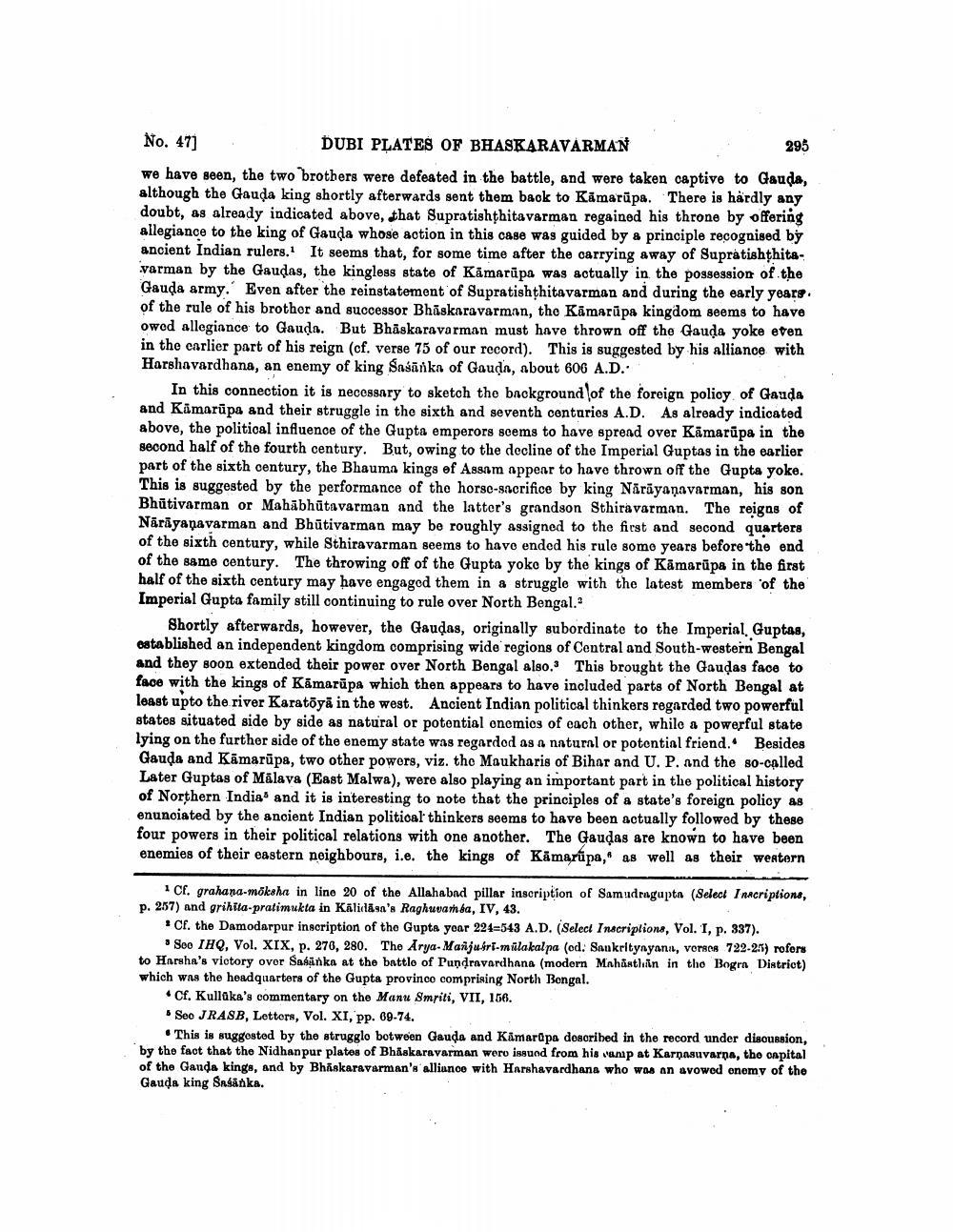________________
No. 47]
DUBI PLATES OF BHASKARAVARMAN
295
we have seen, the two brothers were defeated in the battle, and were taken captive to Gauda, although the Gauda king shortly afterwards sent them back to Kamarupa. There is hardly any doubt, as already indicated above, that Supratishthitavarman regained his throne by offering allegiance to the king of Gauda whose action in this case was guided by a principle recognised by ancient Indian rulers. It seems that, for some time after the carrying away of Supratishthitavarman by the Gaudas, the kingless state of Kamarupa was actually in the possession of the Gauda army. Even after the reinstatement of Supratishthitavarman and during the early years. of the rule of his brother and successor Bhaskaravarman, the Kamarupa kingdom seems to have owed allegiance to Gauda. But Bhaskaravarman must have thrown off the Gauda yoke even in the carlier part of his reign (cf. verse 75 of our record). This is suggested by his alliance with Harshavardhana, an enemy of king Sasanka of Gauda, about 606 A.D.
In this connection it is necessary to sketch the background of the foreign policy of Gauda and Kamarupa and their struggle in the sixth and seventh centuries A.D. As already indicated above, the political influence of the Gupta emperors seems to have spread over Kamarupa in the second half of the fourth century. But, owing to the decline of the Imperial Guptas in the earlier part of the sixth century, the Bhauma kings of Assam appear to have thrown off the Gupta yoke. This is suggested by the performance of the horse-sacrifice by king Näräyanavarman, his son Bhütivarman or Mahabhutavarman and the latter's grandson Sthiravarman. The reigns of Nārāyaṇavarman and Bhutivarman may be roughly assigned to the first and second quarters of the sixth century, while Sthiravarman seems to have ended his rule some years before the end of the same century. The throwing off of the Gupta yoke by the kings of Kamarupa in the first half of the sixth century may have engaged them in a struggle with the latest members of the Imperial Gupta family still continuing to rule over North Bengal.
Shortly afterwards, however, the Gaudas, originally subordinate to the Imperial, Guptas, established an independent kingdom comprising wide regions of Central and South-western Bengal and they soon extended their power over North Bengal also. This brought the Gaudas face to face with the kings of Kamarupa which then appears to have included parts of North Bengal at least upto the river Karatoya in the west. Ancient Indian political thinkers regarded two powerful states situated side by side as natural or potential enemics of each other, while a powerful state lying on the further side of the enemy state was regarded as a natural or potential friend. Besides Gauda and Kamarupa, two other powers, viz. the Maukharis of Bihar and U. P. and the so-called Later Guptas of Mälava (East Malwa), were also playing an important part in the political history of Northern India and it is interesting to note that the principles of a state's foreign policy as enunciated by the ancient Indian political thinkers seems to have been actually followed by these four powers in their political relations with one another. The Gaudas are known to have been enemies of their eastern neighbours, i.e. the kings of Kamarupa, as well as their western
1 Cf. grahana-mōksha in line 20 of the Allahabad pillar inscription of Samudragupta (Select Inscriptions, p. 257) and grihita-pratimukta in Kalidasa's Raghuvamba, IV, 43.
Cf. the Damodarpur inscription of the Gupta year 224-543 A.D. (Select Inscriptions, Vol. I, p. 337).
See IHQ, Vol. XIX, p. 276, 280. The Arya-Mañjuri-mülakalpa (ed. Sankrityayana, verses 722-25) rofers to Harsha's victory over Sasanka at the battle of Pundravardhana (modern Mahasthan in the Bogra District) which was the headquarters of the Gupta province comprising North Bengal.
Cf. Kullaka's commentary on the Manu Smriti, VII, 156.
5 See JRASB, Letters, Vol. XI, pp. 69-74.
This is suggested by the strugglo botween Gauda and Kamarupa described in the record under discussion, by the fact that the Nidhanpur plates of Bhaskaravarman wero issued from his vamp at Karnasuvarna, the capital of the Ganda kings, and by Bhaskaravarman's alliance with Harshavardhana who was an avowed enemy of the Gauda king Sasanka.




